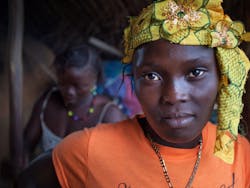Arizona State University (ASU) researchers have unveiled a rapid microgrid design that aims to cut design costs and speed acceleration of electrification in rural areas and undeveloped countries.
ASU is now using the design in Sierra Leone on the coast of West Africa, a project that highlights the benefits of electrification to women and girls.
Researchers developed the microgrid mapping project to reduce the cost and time involved in minigrid and microgrid feasibility assessments, especially in emerging markets, said Nathan Johnson, associate professor at The Polytechnic School at ASU and director of ASU’s Laboratory for Energy And Power Solutions (LEAPS).
The researchers say their system can cut design costs by 60% to 80% and by 90% for the time required for site assessments of mini grids — off-grid systems — as well as microgrids that are tied to the grid.
The effort in Sierra Leone is getting a boost from students, who are participating through YouthMappers, along with the Mapillary and ASU teams. YouthMappers are students worldwide who use public geospatial technology to help identify settlement patterns, road networks and existing electrical grid infrastructure to help with development. Mapillary, recently acquired by Facebook, provides street level views and map data.
No more knocking on doors
Without this remote mapping, feasibility studies involve time-consuming in-person visits, said Johnson.
In developing countries, in-person feasibility studies require workers to go door to door and talk to residents and shop keepers, asking about their demand for electricity and ability to pay for it. In addition, workers gather GIS points that identify where generation assets are located. “It’s a person literally walking around and writing down coordinates,” said Elena van Hove, off-grid solutions lead at LEAPS. This can be time-consuming, expensive and inaccurate, she said.
Instead, the ASU project uses remote mapping tools — remote data and GIS information — to map buildings and roads and help locate existing conductors and utility poles.
“The work seeks to greatly reduce the time required for feasibility assessment of minigrids in emerging markets, and further, enhance the technical and financial rigor in analyses,” said Johnson. The goal is to reduce planning time by 80-95% and potentially eliminate the need for in-person visits that are now limited by the COVID-19 crisis, said Johnson.
The next step is completing the power engineering and initial power system analyses, based on the information collected.
Join Microgrid Knowledge at Microgrid 2020 Global for the “Technology Innovation Showcase,” a look at some of the latest innovations in microgrids and distributed energy from CleanSpark, Cummins, FREEDM Systems Center, FuelCell Energy and RTDS. The session runs from 2-3 pm ET, Thursday, Nov. 19. Registration is free only until November 16 or until the platform reaches capacity, whichever comes first.
Attracting investors
The project is also designed to attract investors.
“When funders look to fund, they want financial metrics that are as accurate as possible,” said van Hove. “With limited technical feasibility, they’re not as accurate.”
In Sierra Leone and other undeveloped areas, access to electricity is limited or unreliable, which poses challenges for girls and women. Reliable electricity will help females boost their incomes by offering products and services. And it will reduce the time associated with completing household chores, said van Hove.
“Women are empowered by access to electricity,” she said. With electricity, women and girls can use appliances and electric devices that will help them spend less time completing chores. Electrification will also provide more lighting to extend the work day. In addition, with electricity, women will have more options for working — running hair salons, for example.
If the researchers target user groups such as women, governments may pay for minigrid and microgrid studies and developers may build systems out, said van Hove. The researchers want to design systems that serve the needs of consumers, boost economic development and potentially attract government grants and developers.
“We want to create something that sustains microgrid technology financially and managerially after we leave,” said Johnson.
Image Courtesy Arizona State University
The national grid is now very restricted, serving a limited number of towns in Sierra Leone. It doesn’t meet the demand for electricity. Off-grid minigrids are being developed, and when the national grid is able to expand, the minigrids will be connected to the grid as microgrids, said von Hove.
“Minigrids and microgrids can bring electricity to these communities much faster and more economically than the national grid is able to,” she said. Creating minigrids is less expensive than the cost of extending transmission lines to remote locations.
“If we can build business districts with minigrids and microgrids that provide power 24 hours a day and have high power quality, the certainty of creating viable businesses is higher,” she said.
And all that will happen faster and less expensively with mapping tools — in Sierra Leone and beyond, she said.
“Sierra Leone is just a starting point,” said van Hove.








